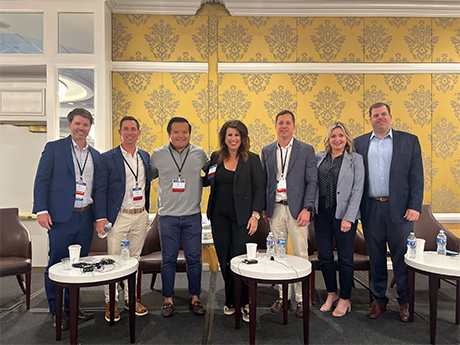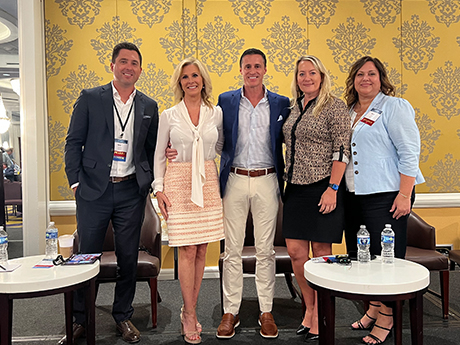Suburban markets in the Carolinas are the big winners in the current multifamily landscape, both from a new development and rent growth perspective, according to the various panelists at the InterFace Carolinas Multifamily conference. Hosted by InterFace Conference Group and Southeast Real Estate Business, the annual event took place on May 25 at the Hilton Charlotte Uptown hotel.
At the end of the leasing and operations panel, moderator Mike Susen, senior director of real estate at Greystar, asked the property managers on stage if they could manage any product type in any Carolinas market, which they would choose. The consensus was their dream assignments lie in the suburbs.
“Let’s do mid-rise suburbs, something out toward Matthews or the Mint Hill area,” said Amanda Kitts, senior vice president of property management at Northwood Ravin, referring to the suburbs of Charlotte. “I’d want to do product that those markets haven’t seen yet.”
“Suburban product is still really strong right now,” added Bob Moore, co-founder and CEO of FCA Management LLC. “Tertiary markets are going to surprise you. You’ll see opportunities to do some deals where there has been a lot lower supply.”
Property managers are keen to handle suburban communities because those markets are not as built out as their urban counterparts, such as Charlotte’s South End or Uptown districts. Thus, operators can seize more opportunities to grow revenue for their owners via higher rental rates.
In the Raleigh-Durham market, average rental rates were up 7 percent year-over-year as of February 2023, according to research from Yardi Matrix. The two cities that saw the most uptick in rents were in Durham County — Carrboro, N.C., which saw an 18.1 percent hike, and Huckleberry Springs, N.C., which rose 14 percent.
Similarly for Charlotte, the best-performing submarkets in terms of rent growth were in the suburbs, according to Yardi Matrix. Lancaster County rose 26.3 percent year-over-year, Statesville-North Iredell County increased by 25.3 percent and Rock Hill-West rose by 16.7 percent. Overall the Charlotte market increased by 8.1 percent.
More room to breathe
Developers are targeting the suburbs in droves as demand for suburban living has grown in recent years. Members of the conference’s development panel said the current office landscape is a major reason.
“Work-from-home and flexible work arrangements are here to stay,” said Josh Glover, senior director of development at Greystar. “We live with that reality every day.”
The panelists of the development update session agreed that the COVID-19 pandemic’s lasting impact has been on the desirability for more space within individual apartments. With higher demand for more space and less of an onus put on proximity to employment centers due to hybrid or remote work arrangements, suburban multifamily markets are a natural benefactor.
Developers said they are building in more coworking spaces into their developments, as well as workspaces within unit interiors. Michael Tubridy, senior managing director of Crescent Communities, said that the Charlotte-based developer is changing unit mixes up completely for its newer projects, especially those in the suburbs.
“We have seen a pretty substantial drop-off in demand for two-bedroom units from where it was pre-COVID,” said Tubridy. “There are fewer roommates because people are in their apartment more and want their own space. Studios are not as hot as they were before, either. People are feeling a little cramped to be in there more than they thought they’d be.”
One of the more large-scale suburban developments to be announced in recent months is South Creek by Beechwood, a 43-acre residential development on the south side of Chapel Hill, N.C. Situated about 30 miles west of Raleigh, the Town of Chapel Hill recently gave unanimous zoning approval to the developer, Beechwood Carolinas, a subsidiary of The Beechwood Organization.
The development will include market-rate and affordable housing apartments and townhomes, for-sale condominiums, 21,000 to 52,000 square feet of commercial and retail space and open gathering areas. Total housing units will total 815 residences.

Additionally, Terwilliger Pappas plans to break ground this September on Solis Birkdale, a 210-unit apartment community in the Charlotte suburb of Huntersville, N.C. The property will serve as the multifamily component of Birkdale Place, a mixed-use development by Gustafson Partners that will also feature a 140-room hotel and conference center and 45,000 square feet of shops and restaurants. Terwilliger Pappas plans to complete Solis Birkdale in the second quarter of 2025. Among the community’s amenities are coworking offices.
The developer also sold Solis Nexton, a community in the Charleston suburb of Summerville, S.C., that was delivered last year.
While the suburbs are growing, there are still plenty of urban developments underway in the Carolinas’ top markets. Some examples include Space Craft’s The Joinery in Charlotte’s Optimist Park neighborhood, Aventon Bees Ferry, a 394-unit property in Charleston’s West Ashley submarket by Aventon Cos., and a new high-rise in downtown Raleigh by Alchemy Properties South and New Valley Realty.
BTR developments fulfill a need
The need for more space in the wake of the COVID-19 pandemic has also been a catalyst for the build-to-rent (BTR) subsector of the multifamily continuum. Coupled with that is the rising cost of land and higher property taxes in the Carolinas core submarkets, thus developers are pioneering new BTR developments in the suburbs as they tend to be more accommodating to the scale needed for these projects to make sense.
“What is really evolving is how far out in the suburbs and to the ‘exurbs’ BTR developers are going,” said Marcie Williams, CEO of RKW Residential, during the BTR update panel. “How far can you go before people will stop and turn around?”
Banyan Residential is developing Banyan Silo Ridge, a BTR community located on a 75-acre site in Wilmington, N.C. The development will offer homes in two-, three- and four-bedroom layouts, each with a one- or two-car attached garage and a private backyard. Community amenities include a 4,000-square-foot clubhouse, fitness center, pool, landscaped grounds and a fenced dog park. Banyan Residential expects to complete the development in the third quarter of 2024.

Additionally, Advenir Oakley Capital LLC has begun site work for LEO Jamestown, a $78 million BTR community in Greer, part of the Greenville-Spartanburg metropolitan area in Upstate South Carolina. The 296-unit project will span nearly 35 acres at the corner of South Main and Roscoe Drive, about one mile outside of downtown Greer.
Managing suburban BTR projects like these can be tricky as the needs for single-family renters are evolving. The panelists said that a typical BTR development in the suburbs will span approximately 200 to 225 homes with back-alley driveways, fenced backyards and attached garages, as well as amenities that include a swimming pool, gathering areas and a clubhouse.
Some BTR developers are thinking outside the box in order to drum up interest from prospective renters. One example is The ITEX Group and Time Warp Enterprises are co-developing The Aronson, a BTR project in Fayetteville, Ark.
The Aronson’s 214 units will be available as single-family, duplex or triplex configurations, but the main attraction will be Alamo Drafthouse Cinema + Drive-In, an entertainment hub developed via a partnership among Catchlight Entertainment, ITEX and Time Warp and operated by Austin, Texas-based Alamo Drafthouse Cinema. In addition to eight indoor movie screens, with a total of 798 reclining theater seats, the concept also includes a permanent outdoor drive-in theater with a beer garden and parking for cars and bikes.
Even with all the bells and whistles, Williams said that ultimately what renters will pay more for are the features inside the home, including simple enhancements like awnings and doggy doors. She added that the BTR industry is still in its infancy, and figuring out what renters expect is a moving target.
“It is very nuanced depending on where the property is located,” said Williams. “We always have to evolve no matter what space we’re in, but [BTR] is still relatively new. So we have thrown out a lot of pages from the playbook we wrote two years and put new ones in their place.”
— John Nelson


